John Rud (1938-2020): A life of mineral exploration

John Rud was a geologist by training and ‘colorful’ by nature. He was layered and you got to see each succeeding layer only with time and trust.
According to his 15-year business partner Clive Ashworth at GeoXplor Corp., you could write books on the stories John has told in his 60 years in the Southwest.
John’s colleague, Bill Fyerabend, remarked that John Rud’s public face was brusque, rude (no pun intended) and cantankerous. As you worked with him more, you began to see a different layer and appreciate his smarts and broad knowledge. When younger, he would quit a job when he had learned all he could from it so he could get on to the next learning experience (job).
His colleague, Nick Barr, commented: “Having shared many early morning humor filled breakfasts in Tonopah, Nevada, I count myself one of the lucky ones to have known geologist John Rud. Right off of a North Dakota farm, teenager John started his geologic journey as a rough and tough, tramp underground miner who was lucky to survive a free-fall plunge in a shaft elevator, only because the older minors hoisted him on their shoulders to cushion the impact. Intrigued by watching a mine geologist, he decided he’d get his master’s degree in geology. Part of field camp duties would find him mapping an overturned ophiolite complex in the Klamath Mountains of southwest Oregon. John would then hold the distinction of being the only University of Oregon grad student whose part time job would see him parking a logging truck outside the geology department. With a keen eye for high-grade, he would apply his mining skills to a number of small underground operations over the years, and bold enough to chase one vein under an Oregon freeway (until he got caught).
“It was always easy for John to find passion for a new avenue of scientific study, earning him a rather remarkable broad knowledge of mining and exploration. Among other things, shop and patio tables covered with bench test mill equipment, and by last count, he had helped design and set up over 30 milling operations.”
With the inevitable boom and bust of mineral exploration, most geologists apply to big companies who themselves just finished laying off geologists. So John would go create his own opportunity by putting a small deposit in production.
That led to more stories like the wild nights in Princeton, British Colombia after finding a placer gold deposit – until the government changed some laws and it ended overnight. Or managing a gold mine in Mexico – until the army showed up and wanted to know who was in charge. John said that he was just a visiting rockhound and excused himself to go to lunch – in the United States.
Or the time they had a Vancouver mining investor lined up to buy a project. He left a signed million dollar cheque on his desk Christmas Eve and died of a heart attack the next day. John occasionally would comment that he would not want to have missed any part because it was all so interesting.
He became talented at building small mine mills and had a small team who started several operations. You could also see all his experience come together when he would fix a recalcitrant lithium brine well pump with the tools in his truck or tie together a hand held X-ray fluorescence rock analyzer so the data fed into his computer which he hooked it to a plotter for big maps.
Finally, you got to know the John who cared about people. He put the Dome mine north of Yuma into production for fluorspar with equipment leases that refunded money when the equipment was returned. When chlorofluorocarbon refrigerants were banned the mine closed overnight. He used the deposit to pay the workers’ last paycheck. When management objected because they wanted the money for themselves, they experienced the rude side of John. On his last big project, he used an 80-year old man with the world’s most rusted bulldozer for earthwork just because.
John lived all the financial ups and downs of mineral exploration. He had to borrow money to get home from Wyoming when uranium went bust. His ship finally came in after he recognized the lithium potential in Nevada’s Clayton Valley that everyone else had overlooked just as lithium batteries boomed. Towards the end, John could comfortably say that he had everything he ever wanted.
John died on May 26 at age 81 in the field with his boots on doing geology. He is survived by former wife Daryl, son Erik, daughter Lisa Beebe, four grandsons and dearest friend of 30 years Jan Lamb.
In the end, John Rud lived a life that was full; he traveled each and every highway and did it his way.

He was the best dad anyone could ask for! He was always there for us with anything we could ever need. We will miss him so much, but he will live on with our memories and fun stories we can tell his grandsons â¤ï¸